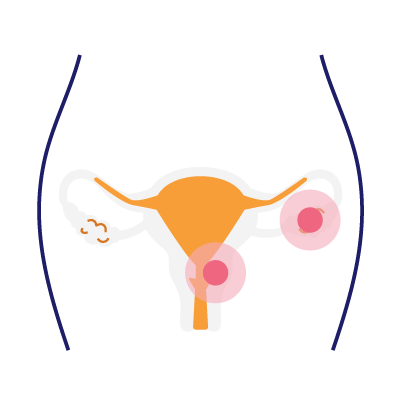
Gynecologic Cancer
Gynecologic cancer are cancers that originate from the female reproductive organs. There are several types of gynecologic cancers which include ovarian, cervical, endometrial, or primary peritoneal cancers.
Ovarian cancer arises from cells in the ovaries or fallopian tubes which have grown abnormally and multiplied to form a tumor. Ovarian cancer is the seventh most common cancer in women and predominantly affects older, postmenopausal women over 50 years old. There are three main types of ovarian cancer: epithelial ovarian cancer, germ cell cancer and stromal cell cancer. Epithelial ovarian cancer is the most common, accounting for approximately 90 percent of ovarian cancers.
Cervical cancer: The cervix is the organ connecting the uterus and the vagina. Cervical cancer is related to infection by certain types of oncogenic Human papillomavirus (HPV) virus. It is a slow-growing cancer and can be prevented by early vaccination against HPV in Europe, and other developed countries. It usually affects young adult women, and unfortunately, it is the third most frequent cancer in women worldwide (about 4% of all cancers diagnosed in women).
Endometrial cancer forms in the tissue lining the uterus. Most endometrial cancers are adenocarcinomas (cancers that begin in cells that make and release mucus and other fluids). Endometrial cancer usually occurs in women over the age of 60, but up to 25% of cases may occur before the menopause.
Primary peritoneal cancer (PPC) is a rare cancer that starts in the layer of tissue called the peritoneum. The peritoneum lines the inside of the abdomen. The cause of PPC is unknown. PPC is more common in older women.
Clinical trials
A ‘clinical trial’ is a research study in which people agree to test a potential new treatment to prevent or improve a disease or medical condition. A clinical trial also looks at how participants react to the potential new treatment and if any unwanted effects occur. This helps to determine if the new investigational treatment works, is safe, and is better than those that are already available. Many clinical trials also compare existing treatments or test new ways to use or combine existing treatments.
Clinical trial of Debio 1143 with nivolumab in specific advanced solid tumors
Debiopharm International is conducting an open-label two-part Phase 1b/2 trial in male and female patients with either small cell lung cancer, squamous cell carcinoma of the head and neck, selected gastrointestinal or gynecologic cancers with specific genetic alterations. Tumors with these genetic alterations may respond better to this study treatment. To be eligible, patients must have received at least one prior standard chemotherapy or have no established standard therapeutic alternatives. In addition, patients must have progressed during prior immuno-oncology treatment.
The purpose of Part B is to evaluate whether Debio 1143 combined with nivolumab leads to efficient shrinkage of the tumor in patients with different types of cancer and to determine how safe it is.
Debio 1143 is an investigational medicinal product. Nivolumab is a monoclonal antibody that specifically blocks a target in the body called PD-1 and stimulates the immune system to fight cancer cells.
Debio 1143 is administered orally once daily for 10 consecutive days every 2 weeks. Nivolumab is administered by infusion every 2 weeks.
-
Phases
When a potential new medication is being developed, it is first tested in a laboratory setting. If the results are positive, the drug may enter a clinical trial program. This means that it will be tested in humans in several ‘phases’ of study.
Phase I = Safety evaluation. The very first administration in humans, typically carried out in a small group of healthy volunteers to assess if the drug is safe.
Phase II = Efficacy evaluation. The first trials in patients with the intended disease to check if the drug works efficiently and if there are any unwanted side effects.
Phase III = Confirming findings. Trials in large numbers of patients that generally compare the drug to the best treatments available._Phases
- P
- Ⅰ
- Ⅱ
- Ⅲ
- M
Please share any related associations that may be useful